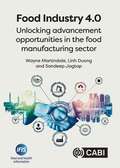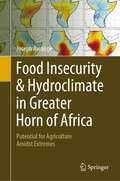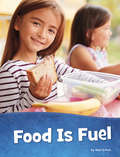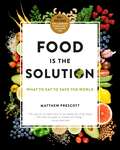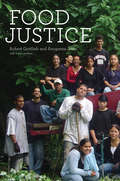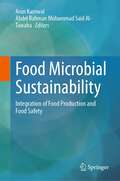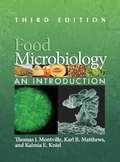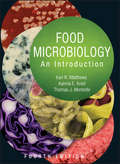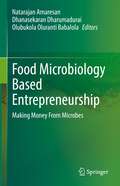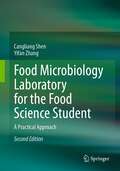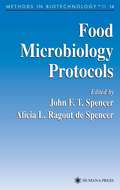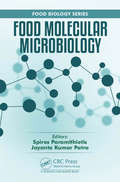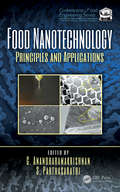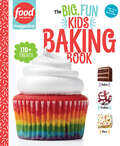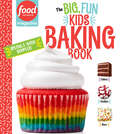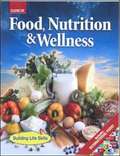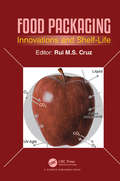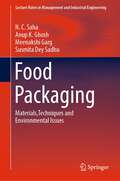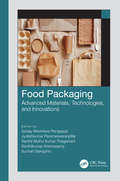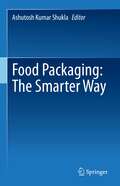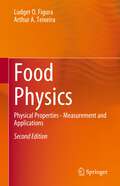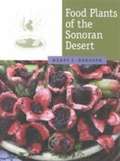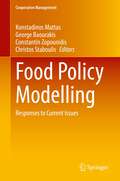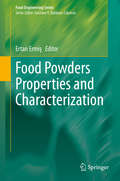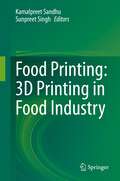- Table View
- List View
Food Industry 4.0: Unlocking Advancement Opportunities in the Food Manufacturing Sector
by Dr Wayne Martindale Dr Linh Duong Dr Sandeep JagtapThis book provides industry insights and fresh ideas for the advancement of the most vital global industry - food. Drawing on their industry and academic expertise the authors have identified three controlling aspects of food business operations that can unleash long term success: consumer health and wellbeing; product and process sustainability; and harnessing advances in digitalization.. If developed to their maximum potential these factors have the capability to revolutionize the food sector. Food Industry 4.0 highlights advancement opportunities for the food manufacturing sector, including innovation in products, processes and services, as it seeks to combine productive, efficient and sustainable practices. The contents address: Mapping data, new approaches for food system applications. The perfect meal and making a balanced global diet possible. Industry 4.0 applications in the food sector: robotics and automation, big data, Internet of Things, cybersecurity. Resource utilization in the food manufacturing sector. Resilience and sustainability in food supply chains. Environmental and social governance in our food system. It is of significant benefit to food industry practitioners working in operational and product development roles, academic researchers, policy makers, students, and food sector professionals.
Food Insecurity & Hydroclimate in Greater Horn of Africa: Potential for Agriculture Amidst Extremes
by Joseph AwangeThis book will benefit users in food security, agriculture, water management, and environmental sectors. It provides the first comprehensive analysis of Greater Horn of Africa (GHA)’s food insecurity and hydroclimate using the state-of-the-art Gravity Recovery and Climate Experiment (GRACE) and its Follow-on (GRACE-FO)’s, centennial precipitation, hydrological models’ and reanalysis’ products. It is here opined that GHA is endowed with freshwater (surface and groundwater) being home to the world's second largest freshwater body (Lake Victoria) and the greatest continental water towers (Ethiopian Highlands) that if properly tapped in a sustainable way, will support its irrigated agriculture as well as pastoralism. First, however, the obsolete Nile treaties that hamper the use of Lake Victoria (White Nile) and Ethiopian Highland (Blue Nile) have to be unlocked. Moreover, GHA is bedevilled by poor governance and the ``donor-assistance” syndrome; and in 2020-2021 faced the so-called ``triple threats’’ of desert locust infestation, climate variability/change impacts and COVID-19 pandemic. Besides, climate extremes influence its meagre waters leading to perennial food insecurity. Coupled with frequent regional and local conflicts, high population growth rate, low crop yield, invasion of migratory pests, contagious human and livestock diseases (such as HIV/AIDs, COVID-19 & Rift Valley fever) and poverty, life for more than 310 million of its inhabitants simply becomes unbearable. Alarming also is the fact that drought-like humanitarian crises are increasing in GHA despite recent progress in its monitoring and prediction efforts. Notwithstanding these efforts, there remain challenges stemming from uncertainty in its prediction, and the inflexibility and limited buffering capacity of the recurrent impacted systems. To achieve greater food security, therefore, in addition to boosting GHA's agricultural output, UN Office for the Coordination of Humanitarian Affairs suggest that its “inhabitants must create more diverse and stable means of livelihood to insulate themselves and their households from external shocks”. This is a task that they acknowledge will not be easy as the path ahead is “strewn with obstacles namely; natural hazards and armed conflicts”. Understanding GHA’s food insecurity and its hydroclimate as presented in this book is a good starting point towards managing the impacts of the natural hazards on the one hand while understanding the impacts associated with extreme climate on GHA's available water and assessing the potential of its surface and groundwater to support its irrigated agriculture and pastoralism would be the first step towards “coping with drought” on the other hand.The book represents a significant effort by Prof Awange in trying to offer a comprehensive overview of the hydroclimate in the Greater Horn of Africa (GHA). Prof Eric F. Wood, NAE (USA); FRSC (Canada); Foreign member, ATSE (Australia).
Food Is Fuel (Health and My Body)
by Mari SchuhWe need food to keep our bodies going. But what are healthy foods and why should we eat them? With engaging text and colorful photos, readers learn how to make healthy food choices. Food Is Fuel includes a glossary, read more section, kid-friendly Internet sites, and an index.
Food is the Solution: What to Eat to Save the World--80+ Recipes for a Greener Planet and a Healthier You
by Matthew Prescott<p>In Food Is the Solution, Matthew Prescott, Senior Food Policy Director for the Humane Society and a leader in the environmental food movement, shows how our plates have the power to heal the world. This lavishly designed resource and recipe collection shows how anyone can help solve the world’s major issues—environmental problems chief among them—simply by incorporating more plants into their diets. <p>Featuring investigative reporting, compelling infographics, and essays from notable contributors like Dr. Michael Greger, John Mackey, James Cameron, Paul McCartney, and Wolfgang Puck, Food Is the Solution will inspire us all to put more plants on our plates. What we eat will determine what kind of world we live in and what kind of world we live on—and Matthew Prescott proves that meat-heavy diets are destroying the planet. <p>Imagine a world in which we are all healthier. Imagine a world where the air is clean, forests dense, water pure, and animal life healthy. That world is a happier world, a better world—and the delectable plant-based foods Prescott shows us how to prepare in Food Is the Solution will help us create it.</p>
Food Justice (Food, Health, and the Environment)
by Robert Gottlieb Anupama JoshiThe story of how the emerging food justice movement is seeking to transform the American food system from seed to table.In today's food system, farm workers face difficult and hazardous conditions, low-income neighborhoods lack supermarkets but abound in fast-food restaurants and liquor stores, food products emphasize convenience rather than wholesomeness, and the international reach of American fast-food franchises has been a major contributor to an epidemic of “globesity.” To combat these inequities and excesses, a movement for food justice has emerged in recent years seeking to transform the food system from seed to table. In Food Justice, Robert Gottlieb and Anupama Joshi tell the story of this emerging movement.A food justice framework ensures that the benefits and risks of how food is grown and processed, transported, distributed, and consumed are shared equitably. Gottlieb and Joshi recount the history of food injustices and describe current efforts to change the system, including community gardens and farmer training in Holyoke, Massachusetts, youth empowerment through the Rethinkers in New Orleans, farm-to-school programs across the country, and the Los Angeles school system's elimination of sugary soft drinks from its cafeterias. And they tell how food activism has succeeded at the highest level: advocates waged a grassroots campaign that convinced the Obama White House to plant a vegetable garden. The first comprehensive inquiry into this emerging movement, Food Justice addresses the increasing disconnect between food and culture that has resulted from our highly industrialized food system.
Food Microbial Sustainability: Integration of Food Production and Food Safety
by Arun Karnwal Abdel Rahman Mohammad Said Al-TawahaThis book reviews all important aspects of Microbial sustainability in food production and food safety with the aim of shedding new light on these microbes through combined understanding of traditional and novel paradigms. The book is divided into three sections, the first of which reinterprets fundamentals of food microbiology, examining the beneficial aspects of microorganisms in food and microbial responses from food environments and preservation. The second section discusses recent advances in understanding of the sustainable food production, covering, for example, agriculturally important microbes, farming microbes, and fermentation. A wide range of bio-factory issues in food production are also addressed, before turning attention to contemporary food safety approaches in the context of novel assessment methods for microbiological food characterization, improving food safety and food quality, etc. The final section is devoted to public health and its importance of microorganisms in food processing as well as the economic importance of microorganisms as this is also an increasingly important area as we move toward microbial research advances.
Food Microbiology: An Introduction
by Thomas J. Montville Karl R. Matthews Kalmia E. KnielThis textbook presents authoritative coverage in a format designed to facilitate teaching and learning. Encourages students to venture beyond memorization and think critically to gain a broader conceptual understanding of food microbiology and acquire the understanding and skills necessary to ensure the safety of tomorrow's food supply. Introduces the genetics and molecular mechanisms important for the understanding of foodborne microbes. Includes expert perspectives on parasites, viruses and prions, and non-thermal processes. Incorporates instructors' input to further clarify complex topics in the field of food microbiology. Presents explicit learning goals to focus students on the core principles of food microbiology.
Food Microbiology: An Introduction (ASM Books)
by Thomas J. Montville Karl R. Matthews Kalmia E. KnielAuthoratative coverage presented in a format designed to facilitate teaching and learning.
Food Microbiology Based Entrepreneurship: Making Money From Microbes
by Natarajan Amaresan Dhanasekaran Dharumadurai Olubukola Oluranti BabalolaThis book is first part of the 3 volume set focusing on basic and advanced methods for using microbiology as an entrepreneurial venture. This book deals with the concept of entrepreneurship skills for production, cost-benefit analysis and marketing of button, oyster, milky mushroom, Ganoderma sp, Single cell protein, Breads, Cheese, Yoghurt, Wine, Beer, Probiotics, Prebiotics fermented vegetables, and Fermented Fish etc. Chapters cover the applications of microorganisms in small and large scale production to achieve a sustainable output. This book provides essential knowledge and working business protocols from all related disciplines of food and dairy industry, probiotics industry, mushroom industry, beverage and baking industry, poultry industry, and aquaculture industry etc. This book is useful to graduate students, research scholars and postdoctoral fellows, and teachers who belong to different disciplines via botany, food microbiology, biotechnology, aquaculture microbiology and poultry microbiology. The other two volumes are focused on agriculture and industrial microbiology.
Food Microbiology Laboratory for the Food Science Student: A Practical Approach
by Cangliang Shen Yifan ZhangThis book is designed to give students an understanding of the role of microorganisms in food processing and preservation; the relation of microorganisms to food spoilage, foodborne illness, and intoxication; general food processing and quality control; the role of microorganisms in health promotion; and federal food processing regulations. The listed laboratory exercises are aimed to provide a hands-on-opportunity for the student to practice and observe the principles of food microbiology. Students will be able to familiarize themselves with the techniques used to research, regulate, prevent, and control the microorganisms in food and understand the function of beneficial microorganism during food manufacturing process. The second edition add 5 new chapters including “Chapter 10 -Thermal inactivation of Escherichia coli O157:H7 in mechanically tenderized beef steaks and color measurements”, “Chapter 11-Evaluate antimicrobial activity of chlorine water on apples and measurement of free chlorine concentrations”, “Chapter 12-Evaluate cross-contamination of Salmonella on tomatoes in wash water using most probable number (MPN) technique”, “Chapter 15-DNA extraction and purity determination of foodborne pathogens”, and “Chapter 16-Practice of multiplex PCR to identify bacteria in bacterial solutions”. It also includes new lab work flowcharts for Gram-staining and endospore-staining technology in Chapter 1, pour plating and spread plating in Chapter 3, Enterotube II in Chapter 9, and Kirby Beau test procedure in Chapter 20. It includes a new sample of syllabus with the hybrid teaching of both lecture and lab sections in one course, which will assist junior faculty/instructors to develop similar lecture and lab courses.
Food Microbiology Protocols
by John F. Spencer Alicia L. Ragout de SpencerExpert laboratorians present a wide ranging set of detailed techniques for investigating the nature, products, and extent of the microorganisms involved in the manufacture and spoilage of foodstuff. The methods cover pathogenic organisms that cause spoilage, microorganisms in fermented foods, and microorganisms producing metabolites that affect the flavor or nutritive value of foods. Included in the section dealing with fermented foods are procedures for the maintenance of lactic acid bacteria, the isolation of plasmid and genomic DNA from species Lactobacillus, and the determination of proteolytic activity of lactic acid bacteria. A substantial number of chapters are devoted to yeasts, their use in food and beverage production, and techniques for improving industrially important strains. Comprehensive and timely, Food Microbiology Protocols is a gold-standard collection of readily reproducible techniques essential for the study of the wide variety of microorganisms involved in food production, quality, storage, and preservation today.
Food Molecular Microbiology (Food Biology Series)
by Spiros Paramithiotis Jayanta Kumar PatraWith the advances in the field of molecular biology, new tools make it possible to conduct in-depth studies in food microbial communities from a molecular perspective. Information from genomic, transcriptomic, proteomic and metabolomic studies can be integrated through bioinformatic applications, thereby improving our understanding of the interactions between biotic and abiotic factors and concomitantly the physiology of starter cultures, spoilage and pathogenic microbiota. Improvements in the speed, accuracy and reliability of food quality and safety assessment have made the foundation stronger for future developments including the exploitation of gene networks and applications of nanotechnology and systems biology. This book reviews all these developments, provides an integrated view of the subject and helps in identifying areas of future development.
Food Nanotechnology: Principles and Applications (Contemporary Food Engineering)
by C. Anandharamakrishnan S. ParthasarathiNanotechnology offers great potential to revolutionize conventional food science and the food industry. The use of nanotechnology in the food industry promises improved taste, flavor, color, texture, and consistency of foodstuffs and increased absorption and bioavailability of nutraceuticals. Food Nanotechnology: Principles and Applications examines the current state of nanoscale phenomena and processes, benefits and risks of nanotechnology. This work contains 18 chapters particularly focused on the design, production, and utilization of nanoparticles, with specific applications for the food industry. Through several studies, it has been proven that nanotechnology can offer distinct advantages over conventional methods in terms of functionality, targeted delivery of food bioactive compounds, improved food quality characteristics like texture, taste, sensory attributes and improved stability in the gastrointestinal tract, and controlled release profiles. Features Offers clear and concise coverage on application of nanotechnology in nutrient delivery, food packaging, and pathogen/pesticide detection Addresses both the technological aspects of delivering nano-based food products and the societal implications that affect take-up Covers broad range of topics including nanoemulsification, electrospraying, nanocomposites, plasma processing, and nanosensors Discusses different formulation and preparation methods for loading food bioactive compounds Exploratory in nature, this book presents the latest of such data on all aspects of applications of nanotechnology in food systems. With its practical focus on the fabrication and application of nanotechnology in food, this book is a valuable resource for students, researchers, food process engineers.
Food Network Magazine The Big, Fun Kids Baking Book: 110+ Recipes for Young Bakers (Food Network Magazine's Kids Cookbooks #2)
by Food Network Magazine Maile CarpenterThe ultimate kids' cookbook for beginner bakers, from the editors of America's #1 food magazine and bestselling authors of The Big, Fun Kids Cookbook.This collection is packed with tons of recipes for easy sweets and treats, designed with young cooks in mind and triple tested by the chefs in Food Network Kitchen. Kids will get all the info they need to make their favorite desserts: muffins and quick breads, brownies and bars, cookies, cupcakes, sheet cakes, and more. The recipes are simple to follow and totally foolproof, and each one comes with a color photo and pro tips to help junior chefs get started in the kitchen. Inside you'll find: • 110+ delicious recipes • Fun food trivia • A visual recipe index with a photo of every recipe • Choose-your-own adventure recipes (such as design-your-own Whoopie Pies and Banana Bread) • Crowd-pleasers like Red Velvet Brownies, Pumpkin Spice Chocolate Chip Cookies, Mini PB & Chocolate Cupcakes, Chocolate Candy Bar Layer Cake, and more! • Fun food crafts such as cookie puzzle pieces and DIY sprinkles • Amazing fake-out cakes including spaghetti and meatballs, a taco, and a pineapple • Bonus food-themed activity pages with word scrambles, spot-the-difference photo games, and more • Lay-flat binding and a heavy paper stock that will stand up to frequent use
Food Network Magazine The Big, Fun Kids Baking Book Free 14-Recipe Sampler!
by Food Network Magazine Maile CarpenterCalling all junior bakers! Check out this special selection of 14 recipes from the first-ever baking book for kids from the editors of Food Network Magazine—including Carrot-Coconut Muffins,Lemon-Raspberry Quick Bread, Peanut Butter Cup Brownies, Butterscotch Blondies, Snack-Attack Cookies with Bacon and S&’mores Cake. Then if you want more, look for all 110 recipes in The Big, Fun Kids Baking Book. It also includes food trivia, tips, food crafts, and other fun activities.
Food, Nutrition & Wellness
by Roberta Larson DuyffMotivate your students to develop healthy eating and fitness habits withGlencoeFood, Nutrition, & Wellness! Authored by a prominent member of theAmerican Dietetic Association Based on the latest in nutrition science and research Writtten in accessible style with many activities to provide applications, practice, and involvement Offers recipes for both All-American favorites and International dishes Focuses on nutrition basics, food prep, and kitchen basics (including a strong focus on safety and sanitation) Illustrates food prep process step-by-step inhow-to features Supports project-based learning with unit-long, hands-on applications Provides point-of-use academic integration (math, science, and English language arts) to help teachers meet Perkins mandates
Food Packaging: Innovations and Shelf-Life
by Rui M. S. Da CruzFood Packaging: Innovations and Shelf-life covers recently investigated developments in food packaging and their influence in food quality preservation, shelf-life extension, and simulation techniques. Additionally, the book discusses the environmental impact and sustainable solutions of food packaging. This book is divided into seven chapters, written by worldwide experts. The book is an ideal reference source for university students, food engineers and researchers from R&D laboratories working in the area of food science and technology. Professionals from institutions related to food packaging.
Food Packaging: Materials,Techniques and Environmental Issues (Lecture Notes in Management and Industrial Engineering)
by N. C. Saha Anup K. Ghosh Meenakshi Garg Susmita Dey SadhuThis comprehensive and authoritative book aims to encompass the best and current practices in the field of contemporary food packaging. It covers various aspects of packaging, including challenges and their solutions, innovations, and environmental concerns. Written by experts working in the field, the content is supported by technical/statistical data, practical examples, case studies, and real-life experiences of academicians and professionals working in the area of food packaging. The book covers challenges in food packaging, systems and materials for packaging, packaging design requirements of the food industry, technology machinery and system, printing and graphics, testing and regulatory aspects, advanced and smart packaging, distribution and logistics in a globalized environment, and sustainable and green packaging. This book will be useful for Packaging Technologists, food scientists, material scientists, policy makers, students, and researchers.
Food Packaging: Advanced Materials, Technologies, and Innovations
by Sanjay Mavinkere Rangappa, Jyotishkumar Parameswaranpillai, Senthil Muthu Kumar Thiagamani, Senthilkumar Krishnasamy and Suchart SiengchinFood Packaging: Advanced Materials, Technologies, and Innovations is a one-stop reference for packaging materials researchers working across various industries. With chapters written by leading international researchers from industry, academia, government, and private research institutions, this book offers a broad view of important developments in food packaging. Presents an extensive survey of food packaging materials and modern technologies Demonstrates the potential of various materials for use in demanding applications Discusses the use of polymers, composites, nanotechnology, hybrid materials, coatings, wood-based, and other materials in packaging Describes biodegradable packaging, antimicrobial studies, and environmental issues related to packaging materials Offers current status, trends, opportunities, and future directions Aimed at advanced students, research scholars, and professionals in food packaging development, this application-oriented book will help expand the reader’s knowledge of advanced materials and their use of innovation in food packaging.
Food Packaging: The Smarter Way
by Ashutosh Kumar ShuklaThis book reviews the science and technology of food packaging and covers the potential innovations in the food packaging sector. At the same time, it highlights the issues and prospects for linking the laboratory research to the market. In addition to typical packaging requirements such as food quality, shelf life, protection, communication, and marketing, the book emphasizes the need for novel packaging materials, including biodegradable packaging for a variety of food products. A wide range of food products has been kept in focus and includes animal-based food products such as dairy products and sea foods. The book presents the next level of packaging solutions i.e., smart packaging with the applications of potential tools such as intelligent and active packaging, and includes the latest research on emerging digital technologies for packaging development, assessment, and acceptability. It further highlights the strategies including blends, reinforcing agents, cold plasma, UV light applications, chemical, and enzymatic methods and explores the new opportunities leading to improvement in the packaging performance. Smart freshness indicator applications, including gas and time-temperature indicators for quality and safety of packaged products, have been covered in detail. The book also includes the functional characteristics of edible films and coatings, including their bioactive characteristics. Finally the book presents the rules and regulation related to packaging.
Food Physics: Physical Properties - Measurement and Applications
by Ludger O. Figura Arthur A. TeixeiraThis is the first textbook in this field of increasing importance for the food and cosmetics industries. It is indispensable for future students of food technology and food chemistry as well as for engineers, technologists and technicians in the food industries. It describes the principles of food physics starting with the very basics – and focuses on the needs of practitioners without omitting important basic principles. It will be indispensable for future students of food technology and food chemistry as well as for engineers, technologists and technicians in the food industries. Food Physics deals with the physical properties of food, food ingredients and their measurement.
Food Plants of the Sonoran Desert
by Wendy C. HodgsonThe seemingly inhospitable Sonoran Desert has provided sustenance to indigenous peoples for centuries. Although it is to all appearances a land bereft of useful plants, fully one-fifth of the desert's flora are edible. This volume presents information on nearly 540 edible plants used by people of more than fifty traditional cultures of the Sonoran Desert and peripheral areas. Drawing on thirty years of research, Wendy Hodgson has synthesized the widely scattered literature and added her own experiences to create an exhaustive catalog of desert plants and their many and varied uses. Food Plants of the Sonoran Desert includes not only plants such as gourds and legumes but also unexpected food sources such as palms, lilies, and cattails, all of which provided nutrition to desert peoples. Each species entry lists recorded names and describes indigenous uses, which often include nonfood therapeutic and commodity applications. The agave, for example, is cited for its use as food and for alcoholic and nonalcoholic beverages, syrup, fiber, cordage, clothing, sandals, nets, blankets, lances, fire hearths, musical instruments, hedgerows, soap, and medicine, and for ceremonial purposes. The agave entry includes information on harvesting, roasting, and consumption-and on distinguishing between edible and inedible varieties. No other source provides such a vast amount of information on traditional plant uses for this region. Written to be easily accessible to general readers, the book is an invaluable compendium for anyone interested in the desert's hidden bounty.
Food Policy Modelling: Responses to Current Issues (Cooperative Management)
by Konstadinos Mattas George Baourakis Constantin Zopounidis Christos StaboulisIn the present economic, political, societal and environmental landscape, which is dominated by the COVID-19 pandemic, the emergence of challenges and issues that demand immediate and urgent responses is more intense than ever. Policymakers, international organizations, governmental and non-governmental institutions around the globe are seeking effective and sustainable policies, as they try to tackle far-reaching issues that affect all aspects of the economy and agriculture, including the food sector. In this context, this book presents new modelling approaches and their application to complex problems in the agro-food chain in order to address today’s pressing food policy issues. The respective chapters showcase national and regional studies on sustainable communities, rural environments and ecosystems. Taken together, they offer a valuable reference guide for scholars and practitioners alike.”
Food Powders Properties and Characterization (Food Engineering Series)
by Ertan ErmişFood powders are an increasingly important aspect of processed food worldwide. Essential factors such as ease of storage and transport and usage convenience have greatly benefited the food industry and promise further advancements in processing techniques. Food powders can be stored for a longer period of time than other food products, making them essential for food supply in many regions of the world. There have been numerous research works on food powders properties and characterization, but there has not been an updated comprehensive review in this field. Food Powders Properties and Characterization is designed as an essential reference for individuals in the food industry and academia seeking a singular source that covers most of the basic aspects of food powders. With chapters focusing on the general properties of food powders, characterization of particle and bulk properties, adhesion and surface properties, this text presents comprehensive and fully up to date coverage of this challenging and important field.
Food Printing: 3D Printing in Food Industry
by Kamalpreet Sandhu Sunpreet SinghThis book provides a comprehensive overview of the technical notes, research designs, literature, and 3DP (three-dimensional printing) technology applications for effective food printing. It provides a multidisciplinary coverage of 3D food printing in different food sectors. Recent advancements in manufacturing processes have led food industries to create innovations to stay competitive in the market. 3D food printing incorporates 3DP digital gastronomy strategies to manufacture food products with consistency in shape, color, flavor, texture, and even nutrition. Thus, by controlling the number of materials and the quality of nutrients, food items can be manufactured and handled to fulfill their particular requirements. For food printing, both proprietary structures and self-developed frameworks are used from open sources. Similar frameworks are re-engineered to reformulate administration, content creation, and user interface. For example, three printing medium types, natural printable products, non-printable synthetic food products, and alternative ingredients as well as two recipe forms (i.e., element-based recipes and regular recipes) are used for customized food production. The authors address that open 3D technology for food printing and food processing technology are theoretically correlated with food printing. The book will help industrial designers, nutrition professionals, dieticians, manufacturing enterprises, and young researchers in food technology, material science, and mechanical engineering understand the latest advances in 3DP technology in food industries.
